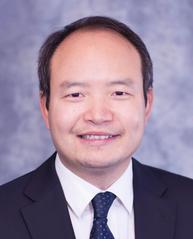
Brief CV:
Guohua Cao is an Associate Professor and Director of X-ray Systems Laboratory in School of Biomedical Engineering, ShanghaiTech University, China. His research is directed at the broad field of biomedical imaging, with a focus on developing novel imaging hardware and software for image acquisition and formation. He has published over 90 peer-reviewed publications in IEEE, Medical Physics, and Physics in Medicine and Biology, etc. He received various awards including a 2014 NSF CAREER award. His team is responsible for developing the world’s first functioning carbon nanotube dynamic micro-CT, which can CT image a beating mouse heart with unprecedented clarity.
After obtaining his PhD in Chemistry from Brown University in 2005, Dr. Cao has worked as an Assistant Professor of Physics at University of North Carolina at Chapel Hill (2009-2011), and an Assistant Professor of Biomedical Engineering at Virginia Tech (2011-2019). Before moving to ShanghaiTech, he spent two years (2019-2021) working as a Research Scientist in the Department of Computer Science at Virginia Tech.
Research Interests:
Biomedical Imaging
X-ray/CT/Micro-CT/Nano-CT
Field Emission X-ray Source and Imaging System
Tomographic Reconstruction
Artificial Intelligence/Deep Learning
Imaging Applications in Cancer/Stroke/COVID-19/Cardiovascular Disease
Courses:
BME2104 – “Biomedical Imaging Technologies”, ShanghaiTech University
BMES 3134 – “Introduction to Biomedical Imaging”, Virginia Tech
BMES 6514 – “Medical Imaging II”, Virginia Tech
BMES 5984 – “Radiation in Imaging and Therapy”, Virginia Tech
BMES 5054 – “Quantitative Cell Physiology”, Virginia Tech
TBMH 5024 – “Fundamentals of Cancer”, Virginia Tech
MSTC 735– “Techniques in Materials Characterization”, UNC-Chapel Hill
CH116 – “Physical Chemistry Laboratory”, Brown University
Services to External Academic Communities:
Journal Reviewer:
IEEE Transactions on Medical Imaging, Medical Physics, Nanotechnology, Scientific Report, PLOS ONE, IEEE Journal of Selected Topics in Signal Processing, Journal of Medical Imaging, Journal of Medical Imaging and Health Informatics, Journal of X-ray Sci. & Tech., Sensors, Microscopy and Microanalysis, Computer Methods and Programs in Biomedicine, Computer Methods in Biomechanics and Biomedical Engineering, Journal of Vacuum Science & Technology, Optical Engineering, etc.
Professional Memberships:
2009- Member, International Society for Optical Engineering (SPIE)
2011- Member, Biomedical Engineering Society
2018- Senior Member, Institute of Electrical and Electronics Engineers (IEEE)
Meeting Co-Chair and Session Chair:
Southeast Biomedical Engineering Career Conference, 2011
BMES Annual Conference, 2015
Publications:
1、Carbon Nanotube X-ray Imaging
I was the lead researcher of many important breakthroughs in the carbon nanotube (CNT) field emission x-ray technology. My team’s research in this direction has brought the CNT x-ray from a proof-of-concept experiment to a general imaging instrument. I developed a CNT micro-CT with dynamic and flexible physiological gating capability, and built several such advanced micro-CT scanners for biomedical researchers at large.
Guohua Cao, Laurel M. Burk, Yueh Z. Lee, Xiomara Calderon-Colon, Shabana Sultana, Jianping Lu, and Otto Zhou, “Prospective-gated cardiac micro-CT imaging of free-breathing mice using carbon nanotube field emission x-ray”, Medical Physics 37, 5306-5312 (2010).
2、New CT Architecture and Imaging Algorithm
I pioneered an innovative CT architecture in which stationary distributed multi-source arrays are used to speed up data acquisition speed and interior region-of-interest oriented scanning mode is utilized to reduce radiation dose.
Zhicheng Zhang, Xiaokun Liang, Xu Dong, Yaoqin Xie, and Guohua Cao, “A Novel Sparse-View CT Reconstruction Method Based on Combination of DenseNet and Deconvolution”, IEEE Trans. on Medical Imaging 37(6), 1407-1417 (2018).
Hao Gong, Bin Li, Xun Jia, and Guohua Cao, Physics Model Based Scatter Correction in Multi-Source Interior Computed Tomography. IEEE Trans. Medical Imaging, 37(20): p. 349-360 (2018).
3、New X-ray Imaging Technique
I have contributed to the advancement of the x-ray phase-contrast imaging, spectral CT imaging, and x-ray fluorescence molecular imaging. My contributions in these areas could potentially enable x-rays to not only image an object’s structure but also its chemistry, physical properties, and more generally functions.
Guohua Cao, Theron Hamilton, Christopher M. Laperle, Christoph Rose-Petruck and Gerald J. Diebold, “X-ray phase contrast imaging: Transmission functions separable in cylindrical coordinates”, J. Appl. Phys. 105, 102002 (2009).
Xu Dong, Cheng Chen, and Guohua Cao, Improving Molecular Sensitivity in X-Ray Fluorescence Molecular Imaging (XFMI) of Iodine Distribution in Mouse-Sized Phantoms via Excitation Spectrum Optimization. IEEE Access 6: p. 56966-56976 (2018).
Complete List of Published Work: https://scholar.google.com/citations?user=OdBCesYAAAAJ&hl=en
Lab Introduction:
Ever since its discovery over a century ago, x-ray has revolutionized every aspect of our lives. A computed tomography (CT) scanner is an x-ray-based imaging device that is capable of providing non-invasive three-dimensional (3D) images, and has a wide range of applications in medical healthcare, industrial inspection, airline security, forensic investigation, scientific research, and many others.
The X-ray Systems Lab aims at developing novel biomedical imaging technologies for biomedical and bioscientific discovery, radiological diagnosis, and medical intervention. Directed by Dr. Guohua Cao, the lab focuses on novel x-ray sources, detectors, signal processing, image reconstruction algorithms, as well as systems engineering. Our research activities are interdisciplinary and translational, and interface between basic sciences, translational development, and clinical applications.
Read more at www.guohuacao.com


